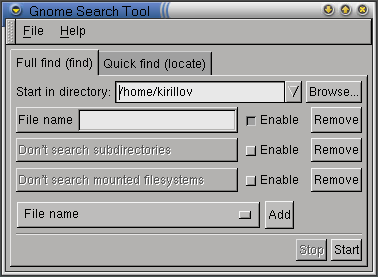Usage
GNOME Search Tool provides two types of search: Full find and Quick find. Full find is reliable and provides many possibilities, but can be slow. Quick find uses special technique for speeding up search; it is much faster, but can only search by filename, and is not as accurate as full find. This section describes full find mode; quick find is described in .
To start a search, you must give the GNOME Search Tool the search criteria and the directory to start in.
By default, the search starts in the current working directory; if the GNOME Search Tool was started from the menu, then the current working directory is your home directory. You can change the starting directory by entering any valid path in the Start in directory field, or by choosing a directory using the Browse... button. For example, to search through all the files in on your system, enter / in this field (warning: it will take very long time).
By default, GNOME Search Tool also searches through all subdirectories of the given directory; you can turn this behavior off by enabling the option Don't search subdirectories. For finer control, you can enable the option Don't search mounted filesystems, which will exclude from the search subdirectories which are physically located (mounted) on drives or partitions other than the starting directory see for details.
The only search criterion presented by default is the Filename. You can use the wildcards * (matches any sequence of symbols, including an empty one) and ? (matches any single symbol) in this field. For example, to find the files with the extension txt, enter *.txt in this field; to find all the files that start with the letter D, enter D* (warning: file names are case-sensitive!). You can also specify much more complicated search criteria see .
After you have specified the search criteria and starting directory, press Start. This will take some time (depending on the directory size and system speed), after which you will be presented with a window containing the list of all the files matching your criteria (it may be empty), as shown in . If the search is taking too much time, you can abort it by pressing Stop button.
In the search results window, you can double-click on any file to open it. It will have the same effect as double-clicking on this file in a File Manager window that is, the file will be opened using the default action for this file type. You can also save the list of found files to disk by pressing Save button. You will be prompted for a filename to save the list to; the list will be saved in a plain text format.

